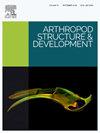The morphology of integumental brochosomes in Cicadellidae (Hemiptera: Auchenorrhyncha)
IF 1.3
3区 农林科学
Q2 ENTOMOLOGY
引用次数: 0
Abstract
Brochosomes, secretory microstructures composed of protein-lipid compounds, are synthesized in the Malpighian tubules of leafhoppers (Cicadellidae). These specialized particles play essential biological roles, notably providing hydrophobic protection against environmental contaminants and self-generated honeydew residues.
This investigation systematically examined the integumental brochosomes morphology in 28 Cicadellidae species representing 12 subfamilies, using optical and scanning electron microscopy (SEM), supplemented by morphological data from 17 additional species extracted from published literature. The resultant comprehensive dataset encompassing 45 species revealed significant morphological divergence in the Hylicinae subfamily relative to other taxa. While most Cicadellidae subfamilies possess submicron-scale brochosomes (<1 μm) with characteristic reticulate surface patterning, Hylicinae specimens exhibited exceptional structural diversity.
Detailed analysis of 8 Hylicinae species identified 4 distinct brochosomes morphotypes classified by surface architecture: rugose, ruminate, foveate, and reticulate types, with foveate and reticulate predominating. Notably, interspecific variation persisted within morphological categories, manifesting through: (1) dimensional disparities in reticular unit size, (2) quantitative differences in surface depression density, (3) presence/absence of secondary granular protrusions, and (4) continuity patterns of surface ridges. These diagnostic structural features suggest brochosomes morphology may serve as both a phylogenetic marker and an adaptive trait reflecting ecological specialization within leafhopper lineages.
蝉科被膜小体的形态研究(半翅目:蝉科)
小体是由蛋白质-脂质化合物组成的分泌微结构,在叶蝉的马尔比氏小管中合成。这些特殊的颗粒起着重要的生物学作用,特别是提供疏水保护,防止环境污染物和自生成的蜜露残留物。利用光学和扫描电子显微镜(SEM)对蝉科12个亚科28个种的被绒小体形态进行了系统的研究,并从已发表的文献中提取了另外17个种的形态资料。由此产生的包含45种的综合数据集显示,相对于其他分类群,Hylicinae亚科在形态上存在显著差异。虽然大多数蝉科亚科具有亚微米尺度的细粒体(<1 μm),具有典型的网状表面图案,但水蛭科标本表现出异常的结构多样性。通过对8种水蛭科植物的详细分析,鉴定出4种不同的染色体形态:褶皱型、反刍型、凹凹型和网状型,以凹凹型和网状型为主。值得注意的是,在形态类别中,种间变异持续存在,表现为:(1)网状单位大小的尺寸差异,(2)表面凹陷密度的数量差异,(3)次生颗粒突起的存在/缺失,以及(4)表面脊的连续性模式。这些诊断性结构特征表明,小体形态既可以作为系统发育标记,也可以作为反映叶蝉谱系生态专门化的适应性状。
本文章由计算机程序翻译,如有差异,请以英文原文为准。
求助全文
约1分钟内获得全文
求助全文
来源期刊
CiteScore
3.50
自引率
10.00%
发文量
54
审稿时长
60 days
期刊介绍:
Arthropod Structure & Development is a Journal of Arthropod Structural Biology, Development, and Functional Morphology; it considers manuscripts that deal with micro- and neuroanatomy, development, biomechanics, organogenesis in particular under comparative and evolutionary aspects but not merely taxonomic papers. The aim of the journal is to publish papers in the areas of functional and comparative anatomy and development, with an emphasis on the role of cellular organization in organ function. The journal will also publish papers on organogenisis, embryonic and postembryonic development, and organ or tissue regeneration and repair. Manuscripts dealing with comparative and evolutionary aspects of microanatomy and development are encouraged.

 求助内容:
求助内容: 应助结果提醒方式:
应助结果提醒方式:


